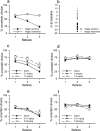Irrational choice under uncertainty correlates with lower striatal D(2/3) receptor binding in rats
- PMID: 23115182
- PMCID: PMC6621583
- DOI: 10.1523/JNEUROSCI.0626-12.2012
Irrational choice under uncertainty correlates with lower striatal D(2/3) receptor binding in rats
Abstract
Individual differences in dopamine (DA) signaling, including low striatal D(2/3) receptors, may increase vulnerability to substance abuse, although whether this phenotype confers susceptibility to nonchemical addictions is unclear. The degree to which people use "irrational" cognitive heuristics when choosing under uncertainty can determine whether they find gambling addictive. Given that dopaminergic projections to the striatum signal reward expectancy and modulate decision-making, individual differences in DA signaling could influence the extent of such biases. To test this hypothesis, we used a novel task to model biased, risk-averse decision-making in rats. Animals chose between a "safe" lever, which guaranteed delivery of the wager, or an "uncertain" lever, which delivered either double the wager or nothing with 50:50 odds. The bet size varied from one to three sugar pellets. Although the amount at stake did not alter the options' utility, a subgroup of "wager-sensitive" rats increased their preference for the safe lever as the bet size increased, akin to risk aversion. In contrast, wager-insensitive rats slightly preferred the uncertain option consistently. Amphetamine increased choice of the uncertain option in wager-sensitive, but not in wager-insensitive rats, whereas a D(2/3) receptor antagonist decreased uncertain lever choice in wager-insensitive rats alone. Micro-PET and autoradiography using [(11)C]raclopride confirmed a strong correlation between high wager sensitivity and low striatal D(2/3) receptor density. These data suggest that the propensity for biased decision-making under uncertainty is influenced by striatal D(2/3) receptor expression, and provide novel support for the hypothesis that susceptibility to chemical and behavioral addictions may share a common neurobiological basis.
Figures





Comment in
-
Gambling rats and gambling addiction: reconciling the role of dopamine in irrationality.J Neurosci. 2013 Feb 20;33(8):3256-8. doi: 10.1523/JNEUROSCI.5828-12.2013. J Neurosci. 2013. PMID: 23426654 Free PMC article. No abstract available.
References
-
- Balleine BW, Dickinson A. Goal-directed instrumental action: contingency and incentive learning and their cortical substrates. Neuropharmacology. 1998;37:407–419. - PubMed
-
- Bateson M, Kacelnik A. Starlings' preferences for predictable and unpredictable delays to food. Anim Behav. 1997;53:1129–1142. - PubMed
-
- Bechara A, Dolan S, Denburg N, Hindes A, Anderson SW, Nathan PE. Decision-making deficits, linked to a dysfunctional ventromedial prefrontal cortex, revealed in alcohol and stimulant abusers. Neuropsychologia. 2001;39:376–389. - PubMed
Publication types
MeSH terms
Substances
Grants and funding
LinkOut - more resources
Full Text Sources
